Sports
/ArcaMax
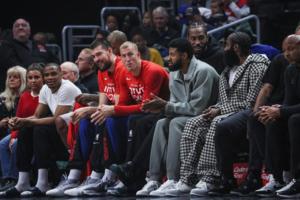
Kawhi Leonard practices with Clippers, but status for Game 1 is unclear
LOS ANGELES — It’s the same old song when it comes to Kawhi Leonard and his availability for the Clippers when they meet the Dallas Mavericks in Game 1 of the Western Conference playoffs on Sunday at Crypto.com Arena.
It remains uncertain — a mystery even — if Leonard will play in the first game of the best-of-seven series.
He missed ...Read more

Blake Griffin announces retirement after 14 years in NBA
NEW YORK — High-flying six-time All-Star Blake Griffin announced his retirement from the NBA on Tuesday.
Griffin, who played 14 seasons with four NBA teams, was picked first overall by the Clippers out of Oklahoma in 2009. He missed the 2009 campaign after suffering a season-ending knee injury in preseason. He returned the following season ...Read more

Greg Cote: More 'Playoff Jimmy' and another Heat postseason miracle way too much to ask ... right?
MIAMI — Championship banners and expectations are raised to commensurate heights, and so it is a compliment to the Miami Heat — to this franchise’s pedigree of accomplishment — to say this team enters the playoffs after an ordinary-to-disappointing regular season and without much hope of a deep run.
Hmm. Sounds familiar. We thought that...Read more

Shakeia Taylor: For Sky fans, tomorrow is here with draft picks Kamilla Cardoso and Angel Reese
CHICAGO — In this year’s SEC tournament championship game, South Carolina center Kamilla Cardoso and LSU forward Angel Reese battled it out in the paint. Two of the game’s biggest stars, they have a history of fierce, physical competition dating to high school.
On Monday night, as the Nos. 3 and 7 picks in a historic WNBA draft class, ...Read more
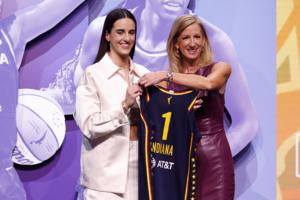
Caitlin Clark is worth millions. Why will she only make $76,535 in the WNBA?
LOS ANGELES — Caitlin Clark is worth millions.
She will make a fraction of that as a WNBA rookie.
Clark, the Iowa phenomenon who set the NCAA basketball scoring record and helped the women's March Madness tournament reach all-time highs in TV ratings, was the No. 1 overall pick for the Indiana Fever in Monday's WNBA draft.
Her jersey sales ...Read more
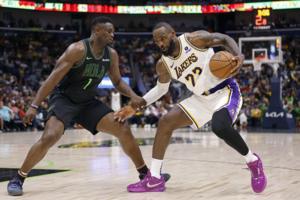
Lakers know Pelicans present problems in rematch, but so does complacency
NEW ORLEANS — The Lakers are going to have to defend against CJ MCollum, the Pelicans guard who races into three-point shots from all angles on the court.
The Lakers are going to have to defend against forward Brandon Ingram, their former first-round draft pick, who has become one of the toughest shot-makers in the NBA.
The Lakers are going...Read more

Worrying about the Timberwolves vs. Suns isn't just typical Minnesota pessimism
MINNEAPOLIS — Timberwolves players have said and will continue to say all the right things about their upcoming playoff matchup, in part because they have to and in part because the world's elite athletes do not thing like you and I do.
The best of the best always believe they can win, and they pay far less attention to data and external ...Read more
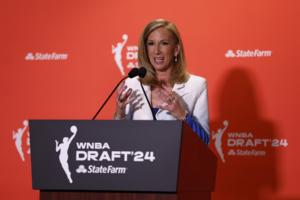
WNBA commissioner Cathy Engelbert 'pretty confident' league will have 16 teams by 2028 season
NEW YORK — Moments before introducing the newest crop of superstars into the WNBA, commissioner Cathy Engelbert announced her plan to have 16 teams for the start of the 2028 season. The commissioner said she’s pretty confident in the league adding four more franchises, which would create 48 more roster spots around the league.
“We’re ...Read more

After Caitlin Clark is drafted No. 1, Sparks select Cameron Brink and Rickea Jackson
For the first time in franchise history, the Sparks were fortunate to have two of the top four picks in the WNBA draft, and the team chose Stanford center Cameron Brink at No. 2, then University of Tennessee forward Rickea Jackson at No. 4 on Monday evening at the Brooklyn Academy of Music.
Brink was selected Pac-12 player of the year after ...Read more
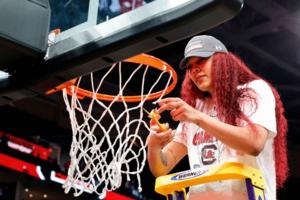
WNBA draft: Chicago Sky pick South Carolina's Kamilla Cardoso at No. 3 and LSU's Angel Reese at No. 7
The Chicago Sky ushered in a new era for the franchise Monday, selecting a pair of national champion frontcourt stars in the first seven picks of the WNBA draft.
The Sky took South Carolina center Kamilla Cardoso with the No. 3 pick and added LSU forward Angel Reese at No. 7. The 6-foot-7 Cardoso is fresh off a star-making performance in the ...Read more
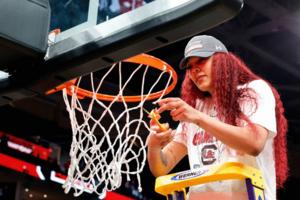
WNBA draft: Chicago Sky select South Carolina star Kamilla Cardoso with the No. 3 pick
The Chicago Sky selected South Carolina star Kamilla Cardoso with the No. 3 pick in the WNBA draft, the next step in a new era for the franchise.
Few players bring the dominant presence in the paint of Cardoso, a 6-foot-7 Brazilian native. Cardoso averaged 14.4 points and 9.7 rebounds in her first year as the primary option for the national ...Read more
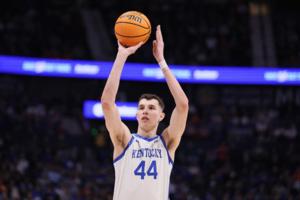
Zvonimir Ivisic is the first former Kentucky player to follow John Calipari to Arkansas
Zvonimir Ivisic is the first Kentucky basketball player to follow former UK head coach John Calipari to Arkansas.
On Monday night, Ivisic committed to Calipari and the Razorbacks out of the NCAA transfer portal. Ivisic, a 7-foot-2 player from Croatia, entered his name into the portal Saturday, one day before Kentucky formally introduced new ...Read more
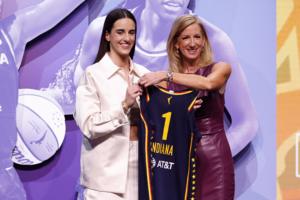
Indiana Fever select Iowa superstar Caitlin Clark with No. 1 pick in WNBA Draft
The No. 1 overall selection in this year’s WNBA Draft was never in doubt. On Monday night, it became official.
The Indiana Fever selected sharp-shooting Iowa superstar Caitlin Clark with the first pick in Monday night’s draft at Brooklyn Academy of Music a little over a week after Clark’s record-setting collegiate career ended with a ...Read more
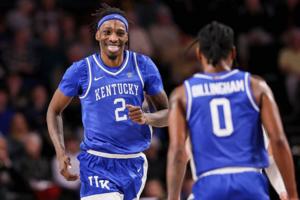
Former Kentucky basketball player Aaron Bradshaw transferring to a Big Ten school
Former five-star Kentucky men’s basketball recruit Aaron Bradshaw has a new college home after spending one season in Lexington.
On Monday afternoon, Bradshaw — who averaged 4.9 points and 3.3 rebounds per game last season at Kentucky — committed to play at Ohio State for Buckeyes head coach Jake Diebler.
Bradshaw committed to the ...Read more

Nick Nurse 'hopeful' Joel Embiid will suit up for Play-In Tournament matchup against Miami Heat
PHILADELPHIA — Nick Nurse shied away from saying it was definitive. Instead, he uttered the word hopeful.
The 76ers coach said he’s hopeful Joel Embiid will play against the Miami Heat in Wednesday’s NBA Play-In Tournament.
“Yeah, hopefully,” he said. “Not sure on anybody, but I’m hopeful.”
After Embiid tweaked his left knee ...Read more

Boban Marjanovic wanted Clippers fans to 'eat mor chikin' for free, so he missed foul shot
No Kawhi Leonard.
No Paul George.
No James Harden.
No way of helping or hurting their playoff status.
Already locked into the No. 4 seed in the Western Conference playoffs, the Clippers gave their stars the day off during the regular-season finale against the Houston Rockets on Sunday at Crypto.com Arena.
But a former Clipper gave the fans ...Read more
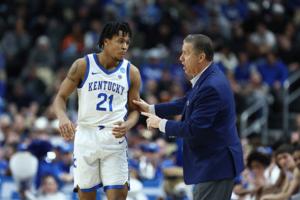
Kentucky's starting point guard is in the transfer portal. All options are on the table
As expected, D.J. Wagner is likely to be a one-and-done player at the University of Kentucky.
Wagner — the Wildcats’ starting point guard during the 2023-24 season — jumped into the transfer portal Monday morning, less than 24 hours after Mark Pope was introduced as UK’s new men’s basketball coach and nearly a week removed from John ...Read more

The OG Anunoby-Precious Achiuwa combo is the Knicks' secret playoff weapon
NEW YORK — DeMar DeRozan got what he wanted — away from OG Anunoby.
It’s overtime of the regular-season finale at Madison Square Garden — a game with zero implications for a Play-In Tournament-bound Chicago Bulls team and direct consequences for the East’s No. 2-seeded Knicks — and DeRozan, the NBA’s reigning Mr. Clutch, has the ...Read more
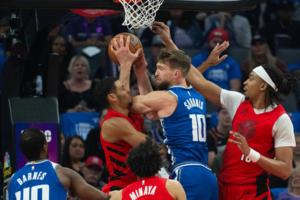
Kings meet little resistance in win over Blazers, but path to playoffs won't be so easy
SACRAMENTO, Calif. — The Kings didn’t encounter much resistance in their regular-season finale against the injury depleted Portland Trail Blazers, but their path to the playoffs won’t be so easy.
De’Aaron Fox scored 24 points on 10-of-14 shooting to lead the Kings to a 121-82 victory over the Blazers on Sunday before a sellout crowd at ...Read more

LeBron James' triple-double helps Lakers secure eighth place for play-in game
NEW ORLEANS — Your eyes would tell you quickly.
The Lakers, at their very best this season, have received the kind of all-around dominance from L eBron James that made him the best player in the league — a surefire ticket to the end when winning mattered most.
But with 39 years on his bones and 21 seasons worth of mileage on his legs, ...Read more
Popular Stories
- Zvonimir Ivisic is the first former Kentucky player to follow John Calipari to Arkansas
- WNBA draft: Chicago Sky pick South Carolina's Kamilla Cardoso at No. 3 and LSU's Angel Reese at No. 7
- Indiana Fever select Iowa superstar Caitlin Clark with No. 1 pick in WNBA Draft
- Lakers know Pelicans present problems in rematch, but so does complacency
- After Caitlin Clark is drafted No. 1, Sparks select Cameron Brink and Rickea Jackson





